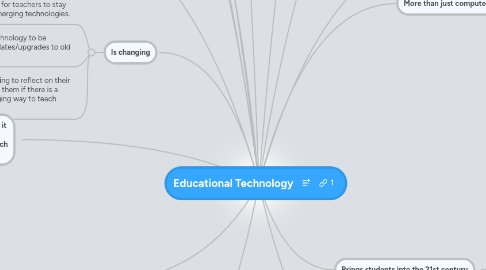Educational Technology
von Michelle Hudiburg


1. Teachers must gauge the effectiveness of technology as it is incorporated into each lesson. Trial and error is important. Proactively evaluate which technologies enrich the students' learning the most.
1.1. Assessments must be developed to gauge effectives
1.2. After reviewing assessments, an action plan must be developed to improve or change what is being implemented.
2. Is changing
2.1. Requires constant professional development for teachers to stay current on emerging technologies.
2.1.1. Requires that the teacher is the first person to want to learn and improve.
2.2. Requires new technology to be purchased or updates/upgrades to old technology.
2.2.1. It needs to be a priority.
2.3. Teachers need to constantly be willing to reflect on their teaching and lessons to restructure them if there is a better/newer/more effective engaging way to teach something.
3. Involves students being actively engaged
3.1. It can help students master concepts
3.2. The student takes control of their learning
3.3. Allows students to apply learned information
3.4. Allows students to get their hands on the materials and use them
4. Is for everyone
4.1. Learners of all ages and abilities can have success and attain mastery of specific skills and standards
4.2. It is engaging
4.3. BUT, must have adequate training/professional development to be successful
4.4. All students can use technology even the ones that struggle with other aspects of education. Technology levels the "playing field."
4.5. Everyone can have fun with this type of learning
4.6. Very visually stimulating and easy to navigate, generally.
5. More than technology for the sake of technology
5.1. Technology should be used as a vehicle for delivering and creating new information.
5.2. The use of technology must be carefully selected and must cater to the students' needs and to the effectiveness of the lesson. Not every technology application suits every kind of lesson.
6. Staff & Students
6.1. With Common Core in the rise, both staff and students need to be responsible in the transition
7. Digital Citizenship
7.1. Students need to be taught how to act appropriately on the internet.
7.1.1. Students should be shown proper researching skills and know what reliable resources are available to them.
7.2. Procedures for using technology devices.
7.3. Students need to be taught how to protect them selves on the internet
8. Connects Educational Topics to Real World Applications
8.1. Enables student to research application while learning new skills
8.2. provides picture and video to supplement lecture and book information
8.3. students can create individual and group presentations to increase peer teaching
9. It is a new concept of literacy in education
9.1. In today's days those who are educated in technology are consider literate.
9.2. Information is everywhere: even in our students' pockets. Students should be ready for the advancing tech
10. learning at an early age
10.1. basics for the very young
10.1.1. building on the already acquired skills
10.1.1.1. utilizing all avenues to build stronger users
11. Isn't an option.
12. Goal Oriented
12.1. objectives clearly stated
12.2. Measure skills
12.3. learning objectives
13. Create appropriate resources
13.1. Apps for learning
13.2. Grade level specific content on common skills
13.3. Not just a basic keyboarding class beginning level 7th grade
14. Use appropriate resources
14.1. Smartboards:
14.1.1. use as more than a projection tool
14.1.2. great tool for student interaction
14.2. IPADS
14.3. Blogs and Wikis
15. More than just computers
15.1. Digital Devices: Smartphones, Tablets, Ipods, etc.
15.2. Smartboards, projectors, etc.
16. Brings students into the 21st century
16.1. Career Readiness
16.1.1. What job these days doesn't require SOME knowledge of technology??
16.2. Information, Media and Skills
16.2.1. Critical Thinking
16.2.2. Communication
16.2.3. Collaboration
16.2.4. Creativity
